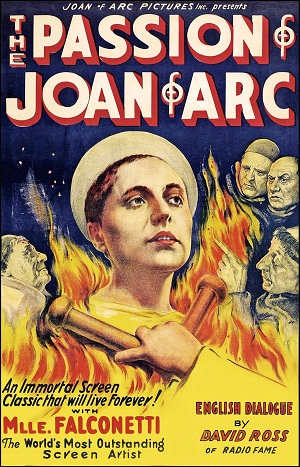The Passion of Joan of Arc (found silent French film; 1928): Difference between revisions
No edit summary |
(Added Found box, fixed grammar and formatting, added references) |
||
| Line 1: | Line 1: | ||
{{InfoboxFound | |||
|title=<center>The Passion of Joan of Arc (1928)</center> | |||
|image=Passionarc.jpg | |||
|imagecaption=Film poster. | |||
|status=<span style="color:red;">'''Found'''</span> | |||
|datefound=1981 | |||
|foundby=Janitor at Dikemark Hospital | |||
}} | |||
'''''The Passion of Joan of Arc''''' is a 1928 silent French film by Carl Theodor Dreyer.<ref>[http://www.imdb.com/title/tt0019254/ IMDb page.] Retrieved 25 Mar '16.</ref> It was incredibly influential and innovative for its time, pioneering new shot types like close-ups. The film chronicled the events of the final days of Joan's life leading up to her execution. The dialogue was taken primarily from her court records. To this day, it is considered one of the most powerful and impressive films of its time. | |||
It also contains what is often considered to be cinema's greatest onscreen performance: Renée Jeanne Falconetti as Joan of Arc. It is often rumored that she got so into acting that she had to be briefly institutionalized for believing she really was Joan of Arc. | |||
The film went through a long and troubled production. Dreyer, a perfectionist, demanded several takes of scenes. Dreyer slaved over hours of raw footage to create his vision of the perfect film. However, the film was met with controversy upon release. | |||
Many theaters refused to screen the film because it portrayed members of the British church so starkly. As such, very few copies of the film were created. It became one of the first films to be destroyed due to it's silver nitrate composition in many studio fires, with the final known copy having been destroyed in 1929 in a lab fire. | |||
The film was re-made using spare footage and alternate takes in 1933 into a briefer 61-minute version. Considered vastly inferior to the original, the film was mostly only shown to people for educational purposes. | |||
The | Dreyer died thinking that his masterpiece was lost forever. Then, in 1981, a janitor found a pristine film reel of the original film in a Swedish mental hospital. The movie was painstakingly restored over the following year and was finally shown to a crowded theater in 1982.<ref>[https://en.wikipedia.org/wiki/The_Passion_of_Joan_of_Arc Wikipedia article.] Retrieved 25 Mar '16.</ref> | ||
Many musical compositions, most notably Richard Einhorn's "Voices of Light," are known to accompany the film today. "Voices of Light" is now acclaimed as one of the greatest film scores of all time. However, some may prefer to watch the film in total silence, as Falconetti's performance and the passion in the film is considered among cinema's most captivating. | |||
==References== | |||
<references/> | |||
[[Category:Lost films|Passion of Joan of Arc (Formerly Missing 1928 Silent French Film)]] | [[Category:Lost films|Passion of Joan of Arc (Formerly Missing 1928 Silent French Film)]] | ||
Revision as of 02:13, 26 March 2016
The Passion of Joan of Arc is a 1928 silent French film by Carl Theodor Dreyer.[1] It was incredibly influential and innovative for its time, pioneering new shot types like close-ups. The film chronicled the events of the final days of Joan's life leading up to her execution. The dialogue was taken primarily from her court records. To this day, it is considered one of the most powerful and impressive films of its time.
It also contains what is often considered to be cinema's greatest onscreen performance: Renée Jeanne Falconetti as Joan of Arc. It is often rumored that she got so into acting that she had to be briefly institutionalized for believing she really was Joan of Arc.
The film went through a long and troubled production. Dreyer, a perfectionist, demanded several takes of scenes. Dreyer slaved over hours of raw footage to create his vision of the perfect film. However, the film was met with controversy upon release.
Many theaters refused to screen the film because it portrayed members of the British church so starkly. As such, very few copies of the film were created. It became one of the first films to be destroyed due to it's silver nitrate composition in many studio fires, with the final known copy having been destroyed in 1929 in a lab fire.
The film was re-made using spare footage and alternate takes in 1933 into a briefer 61-minute version. Considered vastly inferior to the original, the film was mostly only shown to people for educational purposes.
Dreyer died thinking that his masterpiece was lost forever. Then, in 1981, a janitor found a pristine film reel of the original film in a Swedish mental hospital. The movie was painstakingly restored over the following year and was finally shown to a crowded theater in 1982.[2]
Many musical compositions, most notably Richard Einhorn's "Voices of Light," are known to accompany the film today. "Voices of Light" is now acclaimed as one of the greatest film scores of all time. However, some may prefer to watch the film in total silence, as Falconetti's performance and the passion in the film is considered among cinema's most captivating.
References
- ↑ IMDb page. Retrieved 25 Mar '16.
- ↑ Wikipedia article. Retrieved 25 Mar '16.
